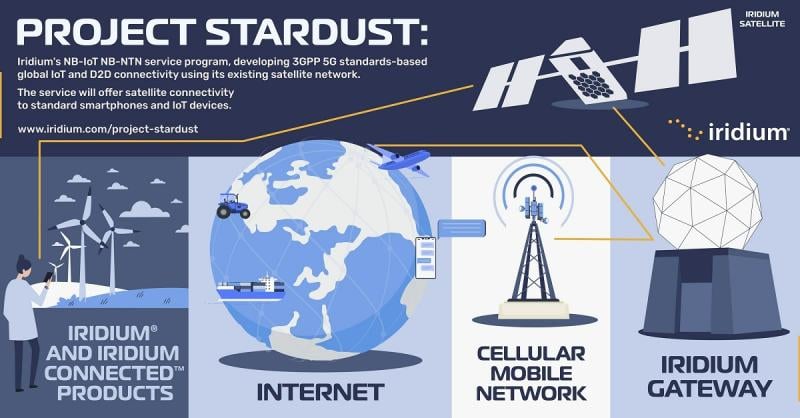It was about a year ago to the day when Iridium Communications announced its deal with Qualcomm to deliver direct-to-device (D2D) satellite connectivity to Android smartphones.
But before the year was over, Qualcomm called it off, saying OEMs weren’t interested in the proprietary solution that Qualcomm and Iridium were pitching.
This week, Iridium unveiled its new D2D strategy, this one based on 3GPP 5G standards-based Narrowband-IoT (NB-IoT) Non-Terrestrial Network (NB-NTN) service development. If that’s a mouthful, be thankful Iridium is shortening all that up to one name: Project Stardust.

‘True global coverage’
Speaking from CES in Las Vegas, Iridium CEO Matt Desch told reporters during a conference call Wednesday that it was a little bit of déjà vu as he was once again talking about D2D at the CES show.
One of the unique aspects of Project Stardust is the combination of new software to be developed for Iridium’s currently deployed low-Earth orbit (LEO) satellite constellation.
“It’s not a trivial effort, but it’s a whole lot less than having to build and launch whole new satellites like others are having to do to address this new opportunity,” he said.
Interest in D2D has been growing ever since Apple introduced its SOS emergency service with Globalstar in 2022. Last week, SpaceX launched the first set of satellites to support its D2D service with T-Mobile.
SpaceX/Starlink, AST SpaceMobile and Lynk Global are re-using terrestrial-based spectrum as part of their strategies. “Those are regional-based solutions,” and they need regulatory approval with new satellites in space, Desch said.
“That’s not what we’re doing. We’re basically using our existing system and using our existing L-band spectrum that is globally approved and supported for a service like this and we’re working with the standards bodies and the chip suppliers so that they embed our frequencies into their standard chipsets,” he said.
Although Iridium doesn’t need to seek funds to launch new satellites, it’s also not a trivial investment. It’s probably “tens of millions” as opposed to hundreds of millions or billions of dollars that rivals are looking to spend. “It’s certainly something we can do within our development envelope and have the ability to do ourselves,” he said.
“We believe we already have the best network. It’s the farthest reaching. It’s the most reliable. We already provide the best IoT service today. We expect that our Project Stardust offering to really continue that trend,” he said.
Setting up partnerships
Iridium has meetings lined up this week with interested stakeholders at CES; he declined to identify who they’re meeting with. A press release indicated that Iridium is already collaborating with the likes of smartphone companies, OEMs, chipmakers, mobile network operators and related IoT developers to have their requirements sync up with the Iridium network.
A big question that came up when Qualcomm announced its intention to end its relationship with Iridium last year revolved around the use of the proprietary approach. Why not go with a standards-based approach out of the gate?
Desch said they initially liked the idea of a quick, proprietary solution for the Android ecosystem and they still think that was a good strategy. But it’s possible that lackluster sales for the iPhone 14 – the first one to support Apple’s SOS satellite messaging service – gave the Android community the impression that they didn’t need to hurry and could take more time to develop a solution based on 3GPP specifications.
Pivoting to the standards-based route “will take a little bit more time” to develop than the proprietary path, he said. The company expects testing to begin in 2025, with service in 2026.